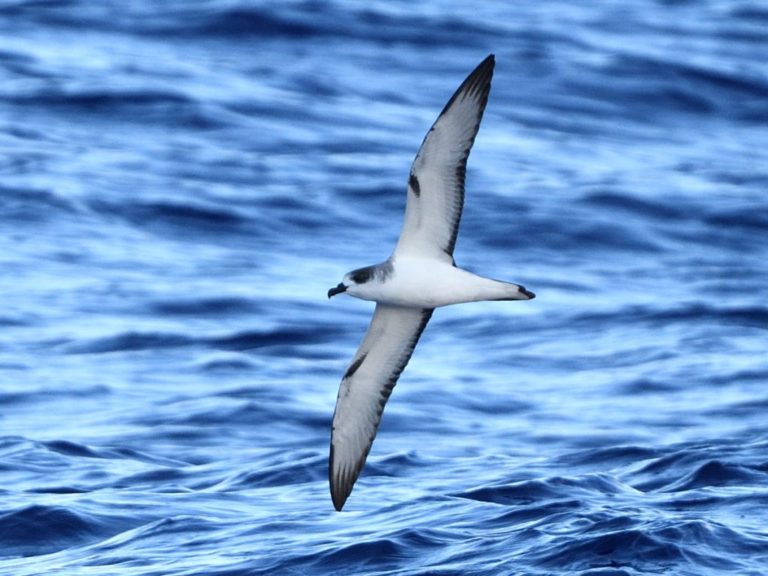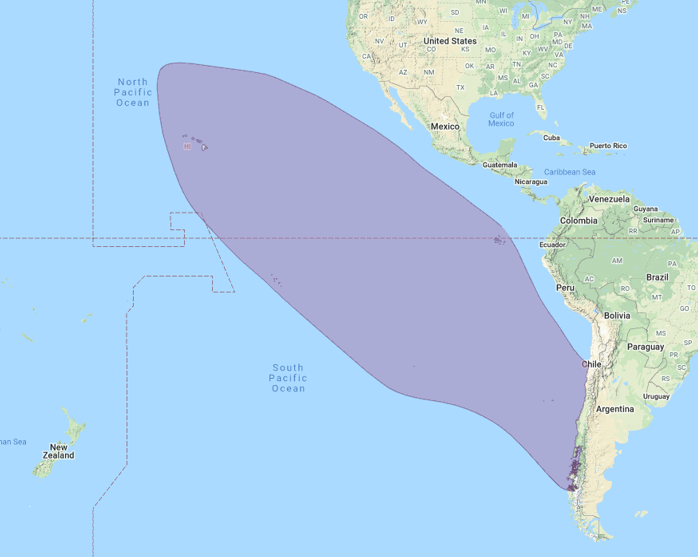Birdfinding.info ⇒ Locally abundant around its sole breeding colony on Isla Alejandro Selkirk and common around neighboring Isla Robinson Crusoe, both over 400 miles west of the Chilean mainland. It can often be found within a few miles of the Chilean coast on boat trips out of Quintero, Valparaíso, and Talcahuano. In Hawaii, it has been found consistently on pelagic trips out of Kailua-Kona from April to October.
Juan Fernández Petrel
Pterodroma externa
Breeds in the Juan Fernández Islands and disperses across the central and eastern Pacific.
Breeding. Breeds from December to May on Isla Alejandro Selkirk (a.k.a. Masafuera), the more distant of the two main Juan Fernández Islands. Nests alongside Stejneger’s Petrel in burrows on slopes in fern-forest, fern-scrub and adjacent meadows and ridges at 600-1,150 m elevations.
The global population is large, estimated in 1986 at one million pairs. IUCN classifies it as “Vulnerable” because it nests only on a single island, and that island is exposed to threats that could be catastrophic for the population, especially the presence of several invasive mammals: cats, rats, goats, and dogs.
Nonbreeding. Disperses extensively across the central and eastern Pacific, throughout Chilean waters, west across Polynesia, and north to Hawaii and Mexican waters. Hawaiian records are concentrated in the southeast, but also regular west to the Northwest Chain.
Wanderers have been recorded several times in the southwestern Pacific, in the waters of southeastern Australia, Tasmania, and New Zealand. There are enough records to suggest that it may occur regularly in very low numbers. Reports from the Chatham Islands include individuals that returned for multiple years, apparently nest-prospecting and possibly breeding.
Vagrants have been recorded west to Japan, north to offshore waters of southern Oregon (sight record, June 7, 2002), and inland at Tucson, Arizona (photographed, September 7, 2016).
Identification
A large, proportionately long-tailed and long-winged gadfly petrel with gray upperparts, a blackish helmet, and nearly all-white underparts—the whitest underparts of any Pterodroma.

Juan Fernández Petrel, showing nearly all-white underparts with black wingtips and “wrist-commas.” (Offshore from Isla Robinson Crusoe, Chile; February 11, 2000.) © Greg Lasley
The face is blackish around the eyes, cheeks, and crown, with a white forehead and throat. The nape is gray, which often extends down the sides of the neck as a partial collar.
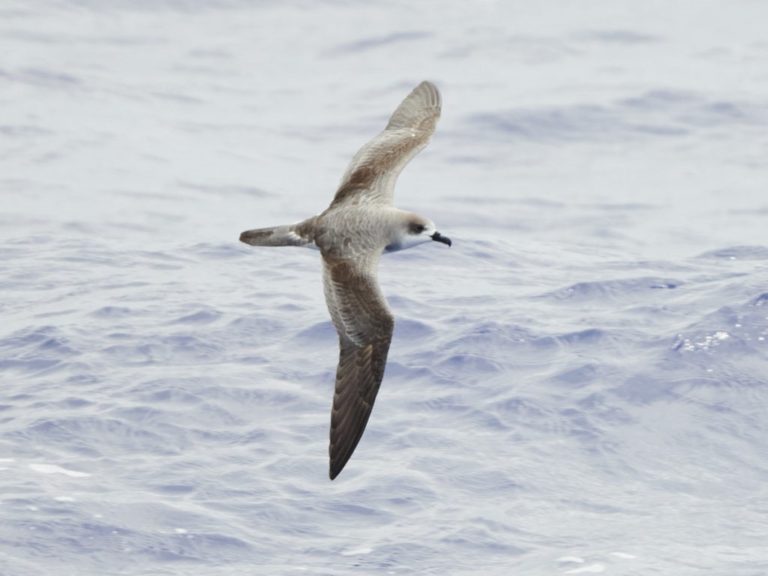
Juan Fernández Petrel, showing strongly-patterned, mostly pale-gray upperparts. (Offshore from the Pitcairn Islands; November 13, 2018.) © Hiroyuki & Shoko Tanoi
The upperparts are varying shades of gray. Depending on molt-stage and lighting, they can appear mostly dark and uniform, but usually appear pale-gray across the back, with dark wings and tail, and a darker “M” across the wings and lower back.
The rump and tail can appear all-dark, but typically have a narrow whitish fringe on the uppertail coverts, sometimes forming a distinct U-shaped rump-band. On some individuals, the base of the tail is infused with white.
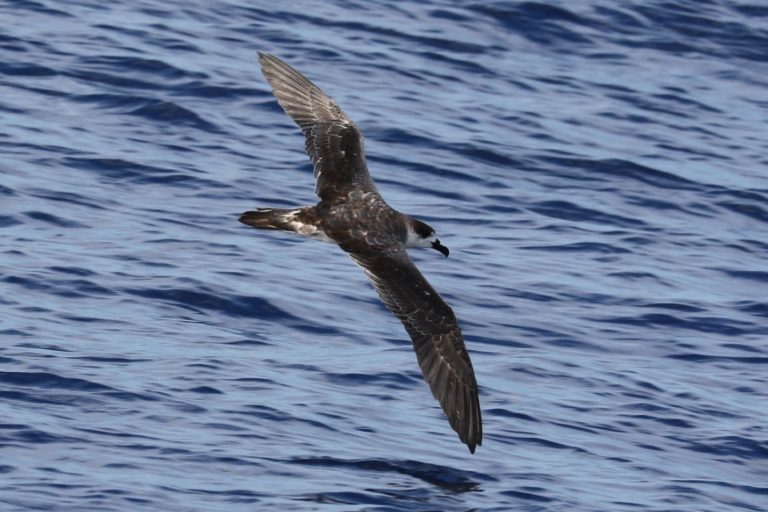
Juan Fernández Petrel, showing mostly dark-gray upperparts—note U-shaped whitish rump band. (Offshore from Kailua-Kona, Big Island, Hawaii; July 23, 2016.) © Annie B. Douglas / Cascadia Research Collective
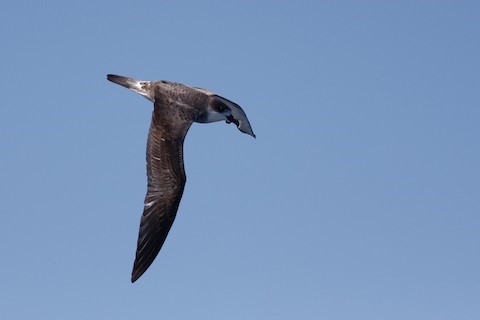
Juan Fernández Petrel, showing mostly dark-gray upperparts—note U-shaped whitish rump band. (Offshore from Valparaíso, Chile; March 3, 2012.) © Raphael Lebrun
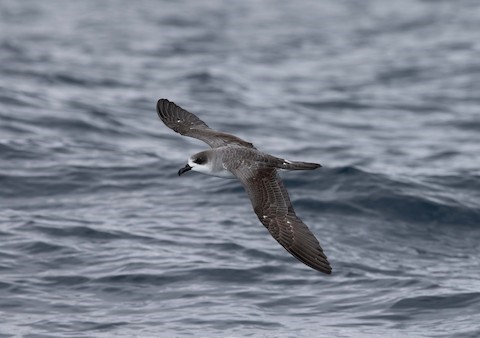
Juan Fernández Petrel, showing typical upperparts coloration in fresh plumage. (Isla Robinson Crusoe, Chile; December 30, 2018.) © Fernando Díaz (Albatross Birding Chile)
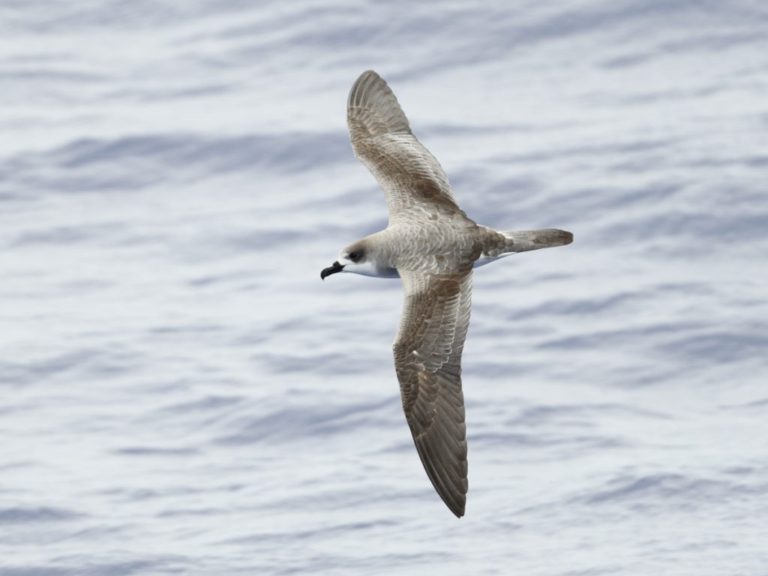
Juan Fernández Petrel, showing strongly-patterned, mostly pale-gray upperparts. (Offshore from the Pitcairn Islands; November 13, 2018.) © Hiroyuki & Shoko Tanoi

Juan Fernández Petrel, showing typical upperparts coloration in fresh plumage—note all-gray rump. (Offshore from Valparaíso, Chile; January 16, 2014.) © Pablo Andrés Cáceres Contreras
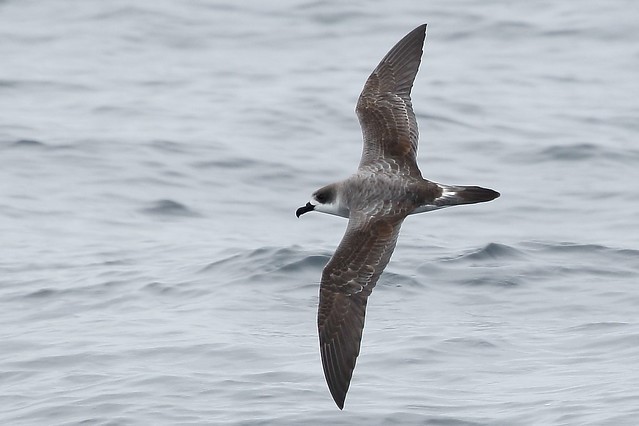
Juan Fernández Petrel, showing typical upperparts coloration in fresh plumage—note small white area on rump. (Offshore from Valparaíso, Chile; December 22, 2013.) © Pablo Andrés Cáceres Contreras

Juan Fernández Petrel, showing typical upperparts coloration in fresh plumage—note all-gray rump. (Isla Robinson Crusoe, Chile; January 9, 2017.) © Fernando Díaz (Albatross Birding Chile)
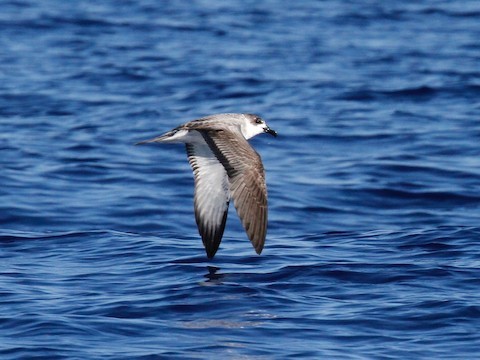
Juan Fernández Petrel, showing strongly contrasting plumage tones above and below. (Offshore from Kailua-Kona, Big Island, Hawaii; October 22, 2017.) © Thane Pratt
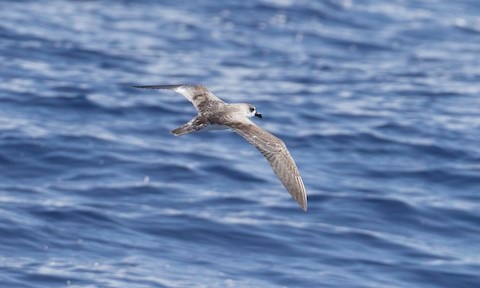
Juan Fernández Petrel, appearing pale in glary lighting. (Offshore from Kailua-Kona, Big Island, Hawaii; September 17, 2017.) © Brian Sullivan

Juan Fernández Petrel, showing mostly dark-gray upperparts in this lighting. (Offshore from Valparaíso, Chile; January 29, 2012.) © Pablo Andrés Cáceres Contreras
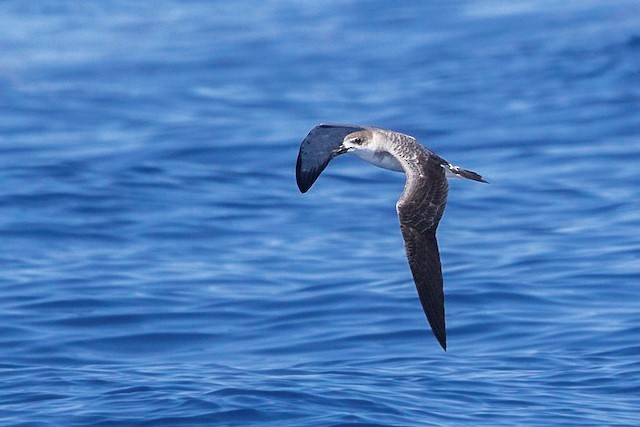
Juan Fernández Petrel in glary lighting—also note its lanky, long-winged appearance. (Offshore from Kailua-Kona, Big Island, Hawaii; September 14, 2018.) © Bradley Hacker

Juan Fernández Petrel, with tail fanned, showing narrow U-shaped whitish rump band. (Offshore from Kailua-Kona, Big Island, Hawaii; October 22, 2017.) © Thane Pratt
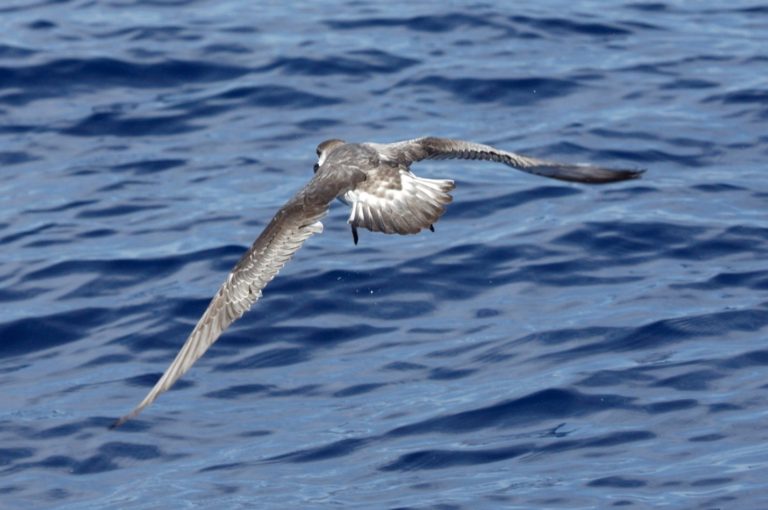
Juan Fernández Petrel, showing unusually extensive white in the rump and the bases of the tail feathers. (Offshore from Kailua-Kona, Big Island, Hawaii; November 14, 2014.) © Julie E. Steelmann / Cascadia Research Collective

Juan Fernández Petrel. (Offshore from Kailua-Kona, Big Island, Hawaii; November 5, 2015.) © Elia Y. Herman / Cascadia Research Collective
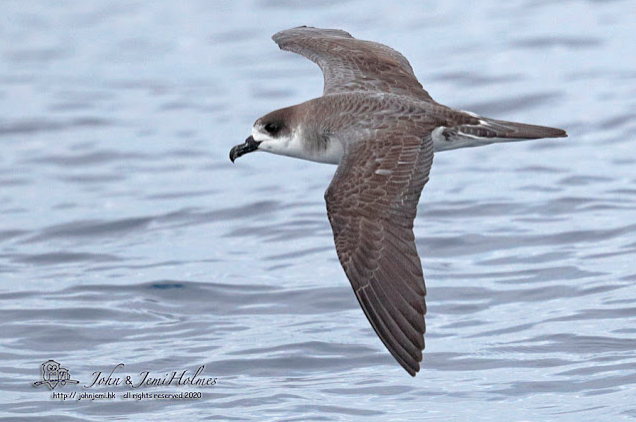
Juan Fernández Petrel, showing subtly-patterned gray upperparts. (Offshore from Isla Alejandro Selkirk, Chile; March 1, 2020.) © John & Jemi Holmes
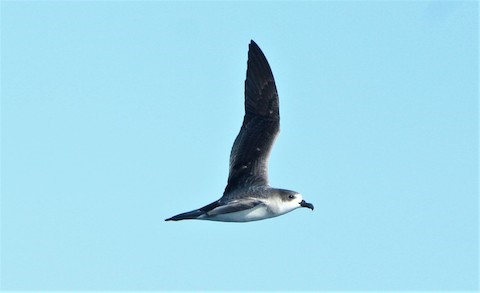
Juan Fernández Petrel, showing mostly uniform dark-gray upperparts in this lighting. (Offshore from Isla Robinson Crusoe, Chile; January 6, 2017.) © Matías Garrido
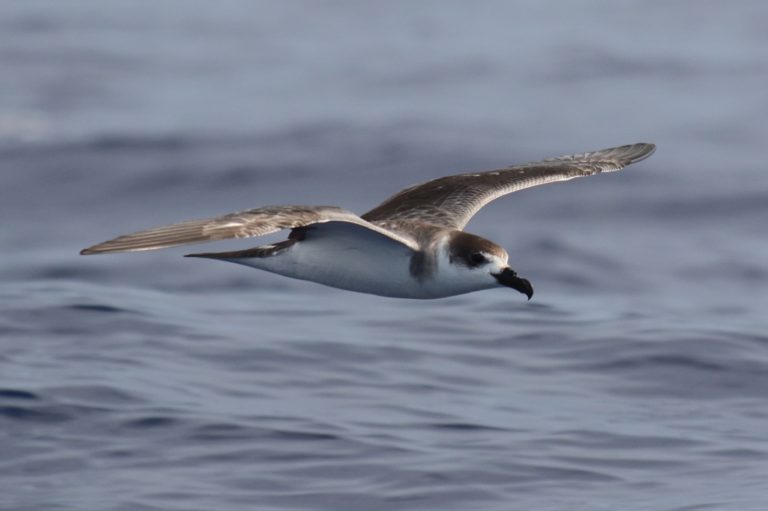
Juan Fernández Petrel, frontal view showing white forehead and gray on the sides of the neck—also showing an apparent white collar, similar to that of White-necked Petrel. (Offshore from Kailua-Kona, Big Island, Hawaii; November 5, 2015.) © Daniel L. Webster / Cascadia Research Collective
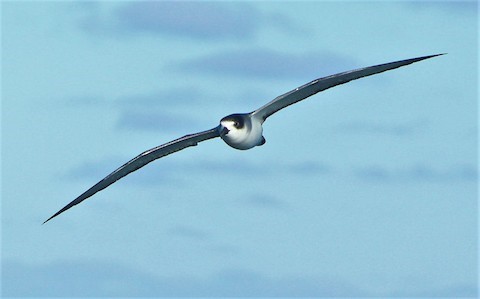
Juan Fernández Petrel, frontal view showing white forehead and gray on the sides of the neck. (Offshore from Isla Robinson Crusoe, Chile; January 6, 2017.) © Matías Garrido

Juan Fernández Petrel, frontal view showing white forehead and gray on the sides of the neck. (Offshore from Kailua-Kona, Big Island, Hawaii; July 23, 2016.) © Annie B. Douglas / Cascadia Research Collective
The underparts are almost entirely white, with narrow black borders on the tail, wingtips, and trailing edge of the wings. The leading edge of the wing is mostly white, with a small black “comma” on the inner side of the wrist.

Juan Fernández Petrel, showing nearly all-white underparts with black wingtips and “wrist-commas.” (Offshore from Eaglehawk Neck, Tasmania, Australia; January 14, 2018.) © Paul Brooks

Juan Fernández Petrel, showing nearly all-white underparts with black wingtips and “wrist-commas.” (Offshore from the Pitcairn Islands; November 13, 2018.) © Hiroyuki & Shoko Tanoi
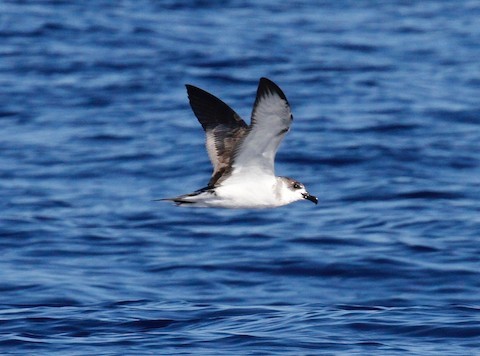
Juan Fernández Petrel, showing mostly white underparts, with gray on the sides of the neck, and black wingtips and “wrist-commas.” (Offshore from Kailua-Kona, Big Island, Hawaii; October 22, 2017.) © Thane Pratt

Juan Fernández Petrel, showing nearly all-white underparts with black wingtips and “wrist-commas.” (Offshore from Kailua-Kona, Hawaii; September 14, 2018.) © Joshua Rudolph
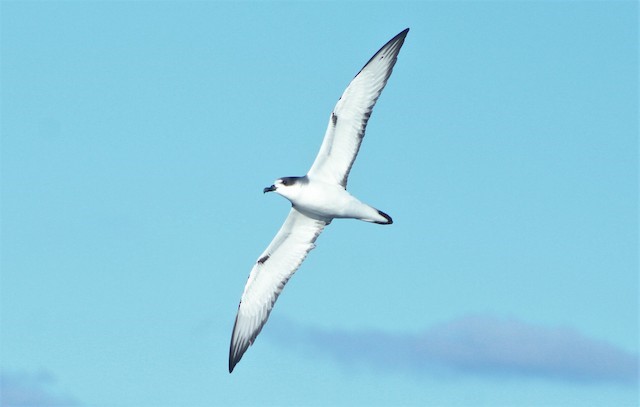
Juan Fernández Petrel, showing nearly all-white underparts with black wingtips and “wrist-commas.” (Offshore from Isla Robinson Crusoe, Chile; January 6, 2017.) © Matías Garrido

Juan Fernández Petrel, showing nearly all-white underparts with black wingtips and “wrist-commas.” (Offshore from the Pitcairn Islands; November 9, 2018.) © Hiroyuki & Shoko Tanoi

Juan Fernández Petrel, showing mostly white underparts, with gray on the sides of the neck, and black wingtips and “wrist-commas.” (Offshore from Kailua-Kona, Big Island, Hawaii; November 5, 2015.) © Daniel L. Webster / Cascadia Research Collective
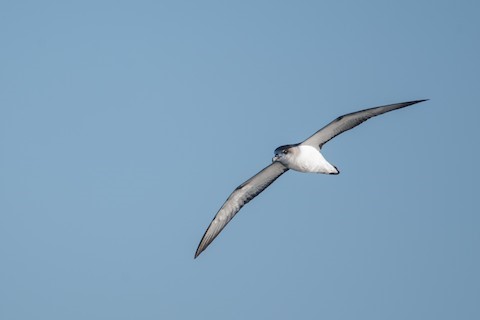
Juan Fernández Petrel—identifiable by its almost all-white underparts. (Offshore from Quintero, Chile; March 4, 2017.) © Vicente Pantoja Maggi
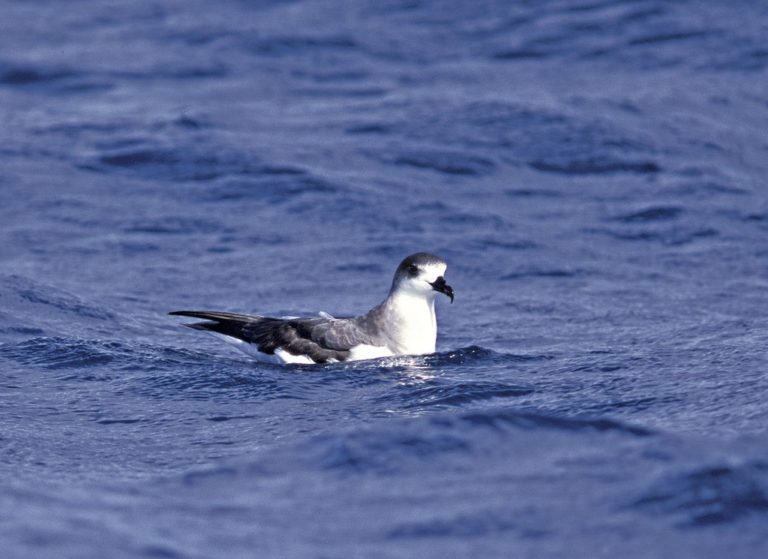
Juan Fernández Petrel. (Offshore from Isla Robinson Crusoe, Chile; February 11, 2000.) © Greg Lasley

Juan Fernández Petrel. (Offshore from Kailua-Kona, Big Island, Hawaii; November 14, 2014.) © Daniel L. Webster / Cascadia Research Collective
Cf. White-necked and Vanuatu Petrels. White-necked, Vanuatu, and Juan Fernández Petrels were formerly regarded as conspecific. They are very similar and overlap widely across the central and southern Pacific—both White-necked and Juan Fernández are fairly common nonbreeding visitors to Hawaiian waters. White-necked and Vanuatu are essentially indistinguishable under field conditions, but Juan Fernández can be distinguished based on its whiter underwings and more uniform upperparts.
White-necked and Vanuatu can usually be identified by their well-defined white collar which separates the black cap from the gray back. Juan Fernández usually shows shades of gray: dark-gray on the crown and medium or pale gray on the back, with a gray collar in between, usually blended and lacking any sharp contrast on the nape. Under some conditions, Juan Fernández can show also a white (or very pale gray) collar, but rarely if ever shows the crisp contrast of White-necked and Vanuatu.
Juan Fernández is usually best identified by its underwing pattern: white with narrow black wingtips and trailing edges, a small black “comma” on the inner side of the wrist, and subtle blackish spotting on the outer primary coverts. White-necked and Vanuatu have more extensive black wingtips and carpal bars.
Notes
Monotypic species. Formerly regarded as conspecific with White-necked Petrel (P. cervicalis) and Vanuatu Petrel (P. occulta), known collectively as the White-necked Petrel (P. externa).
IUCN Red List Status: Vulnerable.
References
Aves de Chile. 2021. Fardela Blanca de Juan Fernández. https://www.avesdechile.cl/440.htm. (Accessed April 30, 2021.)
BirdLife International. 2018. Pterodroma externa. The IUCN Red List of Threatened Species 2018: e.T22698030A132620783. https://dx.doi.org/10.2305/IUCN.UK.2018-2.RLTS.T22698030A132620783.en. (Accessed April 30, 2021.)
Brazil, M. 2009. Birds of East Asia. Princeton University Press.
Brooke, M. 2004. Albatrosses and Petrels across the World. Oxford University Press.
eBird. 2021. eBird: An online database of bird distribution and abundance. Cornell Lab of Ornithology, Ithaca, N.Y. http://www.ebird.org. (Accessed April 30, 2021.)
Harrison, P. 1983. Seabirds: An Identification Guide. Houghton Mifflin, Boston.
Howell, S.N.G. 2012. Petrels, Albatrosses & Storm-Petrels of North America. Princeton University Press.
Howell, S.N.G., and K. Zufelt. 2019. Oceanic Birds of the World. Princeton University Press.
Jaramillo, A. 2003. Birds of Chile. Princeton University Press.
Onley, D., and P. Scofield. 2007. Albatrosses, Petrels & Shearwaters of the World. Princeton University Press.
Pratt, H.D., P.L. Bruner, and D.G. Berrett. 1987. A Field Guide to the Birds of Hawaii and the Tropical Pacific. Princeton University Press.
Pyle, R.L., and P. Pyle. 2017. The Birds of the Hawaiian Islands: Occurrence, History, Distribution, and Status. Version 2 (January 1, 2017). http://hbs.bishopmuseum.org/birds/rlp-monograph/. B.P. Bishop Museum, Honolulu, Hawaii.
Schulenberg, T.S., D.F. Stotz, D.F. Lane, J.P. O’Neill, and T.A. Parker. 2007. Birds of Peru. Princeton University Press.
Seabirding of Japan. 2021. Juan Fernandez Petrel. http://seabirding-japan.com/juan-fernandez-petrel/. (Accessed April 30, 2021.)
Xeno-Canto. 2021. Juan Fernandez Petrel – Pterodroma externa. https://www.xeno-canto.org/species/Pterodroma-externa. (Accessed April 30, 2021.)
